Thermal Paste, otherwise known as thermal compound, thermal gel, heat sink compound, or heat paste just to mention a few, is a high heat conductive adhesive used to improve conduction. It is mostly used between the heat sink and the microprocessor on a computer, seeing that most processors surfaces are not even.
Curves and grooves give way to air gaps, which in turn reduces the heatsink’s cooling performance. However, this can be rectified by applying thermal paste at the bottom of the heatsink and atop the microprocessor. There are several types of thermal paste such as metal-based paste, conductive, ceramic, and silicon-based paste just to mention a few.
While the conductive thermal paste is regarded as superior to its counterparts, it must be applied with a lot of precision and care as it can short-circuit electrical connections. One of the prime reasons most computers function for an extended period is based on their ability to manage heat. Gaining a better understanding of how best to apply thermal paste is key to proper computer cooling.
Here are some tips: otherwise, click here jump straight to the review
How to Apply Thermal Paste
There are different types of computer coolers, each with different thermal gel requirements. So, before using this product on your computer, you first need to know the type of computer cooler your device has, to buy the right thermal paste. I recommend ceramic and silver-based thermal grease because they have better heat transmission but, they are more expensive compared to basic compounds such as zinc oxide and silicon.
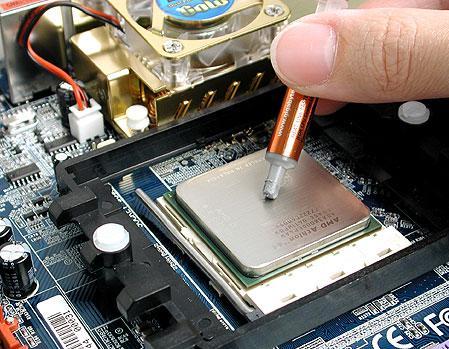
While the former option might be better, most people opt for the latter as it meets their computer requirements. However, if you often overclock, it is advisable to use gold, copper, or silver-based thermal paste. After determining the type of cooling system your computer has and the best adhesive for it, the next step is cleaning the CPU surface using cotton.
Dip the cotton ball into isopropyl with a high alcohol percentage. 90% is good but seeing that 70% is more standard and can also do the job, you can choose the latter. The third and last preparation step is an optional one. Nonetheless, if you are looking to have a computer with the best cooling system, this step is vital.
As mentioned earlier, the processor and heatsink surfaces are not always smooth; otherwise, there wouldn’t be any need for thermal paste. Nonetheless, you can smoothen them using polish and wet-sand for better application. After this procedure, your computer is ready for some thermal paste, and this is how it is applied on the different types of coolers.
• Circular-based Coolers
While most people recommend a pea-sized drop of thermal grease, you are better off with one as small as a grain of rice. You do not want the paste to stretch into your motherboard. A grain-sized drop at the middle of your cooler’s base is enough to do the trick. There’s no need to spread it on these types of coolers, the pressure applied does the job perfectly.
After this step, use equal pressure to attach your heatsink back to the processor and watch the thermal grease spread evenly across the surface. When these two components heat up, the thermal paste is pushed towards the edges, leaving a thin adhesive in the middle. As such, it is wise to apply as little thermal gel as possible.
While confirming whether the thermal gel has spread evenly is important for most people, it may result to repeating the whole procedure, starting from cleaning the surfaces all over again. As such, it is important to go through each step carefully without a rush. You can now reconnect the motherboard and boot your computer.
• Square-based Coolers
There are several ways to apply the paste on square-based coolers, the first is the lines method, which is done by drawing two thin lines on your cooler’s base. Ensure that the lines are even in length and thickness for better results. The other tactic is known as the spread method, which requires you to squeeze a little thermal paste in the middle of your cooler, then spread it using a protected finger.
A plastic bag can do the trick if you do not have a plastic finger protector. This method is the most popular and is preferred by most people due to its ability to ensure that every part of the surface gets an even spread of the required amount of paste. The last method is known as the cross method, and as the name suggests, it involves drawing an X in the middle of the base surface.
After placing the thermal paste, you can now re-install the heat sink, connect your motherboard, and restart your computer.
How to Choose the Best Thermal Paste
Aside from identifying your processor’s and heatsink’s composition, several other factors contribute to purchasing the best thermal paste. Chief of these factors is the price, which you should expect to vary widely seeing the numerous brands of thermal paste currently on the market. However, regardless of the price, look for thermal grease with a temperature limit that is higher than 150 degrees.
Another aspect that should be considered is the paste’s composition. The best thermal paste should have high electrical conductivity for better performance. Also, it should not be very viscous or have poor shelf-life. While some of the ingredients used in most of these products are a carefully guarded secret, it is vital to purchase aluminum-based paste if you wish for the paste to achieve the intended purpose.
Here’s a deeper review of the best thermal pastes currently on the market for your consideration.
Arctic Silver 5 Thermal Paste
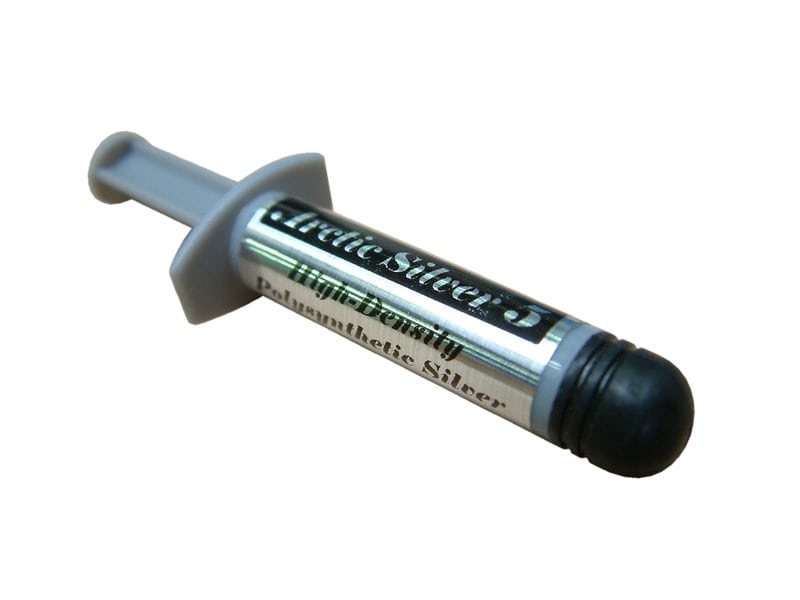
The Arctic Silver 5 Thermal Compound is a paste comprising of 99.9% micronized silver. As such, it can ensure reliable transfer of heat from your heatsink to the CPU and prevent overheating. The Arctic Silver 5 Thermal Compound comes in three sizes and is considered ideal for high-performance heat sinks and modern computers that use up a lot of power.
This thermal paste might be only 3.5 grams, but that is enough to cover over 20 small computer cores. If used on large CPU core, the Arctic Silver 5 Thermal Compound can cover about 5-10 computers. It is non-electricity conductive and is easy to apply or remove. Regarding its thermal conductance, the Arctic Silver 5 Thermal Compound can conduct 350000 W per m2 degrees Celsius.
Not to mention, unlike most thermal pastes, the Arctic Silver 5 Thermal Compound does not bleed, run, or migrate when applied. It comes in two colors namely black and gray, weighs 0.2 ounces, and has a 30-day full refund policy.
Check Price OnlineARCTIC MX-4 Heat Sink Compound Paste
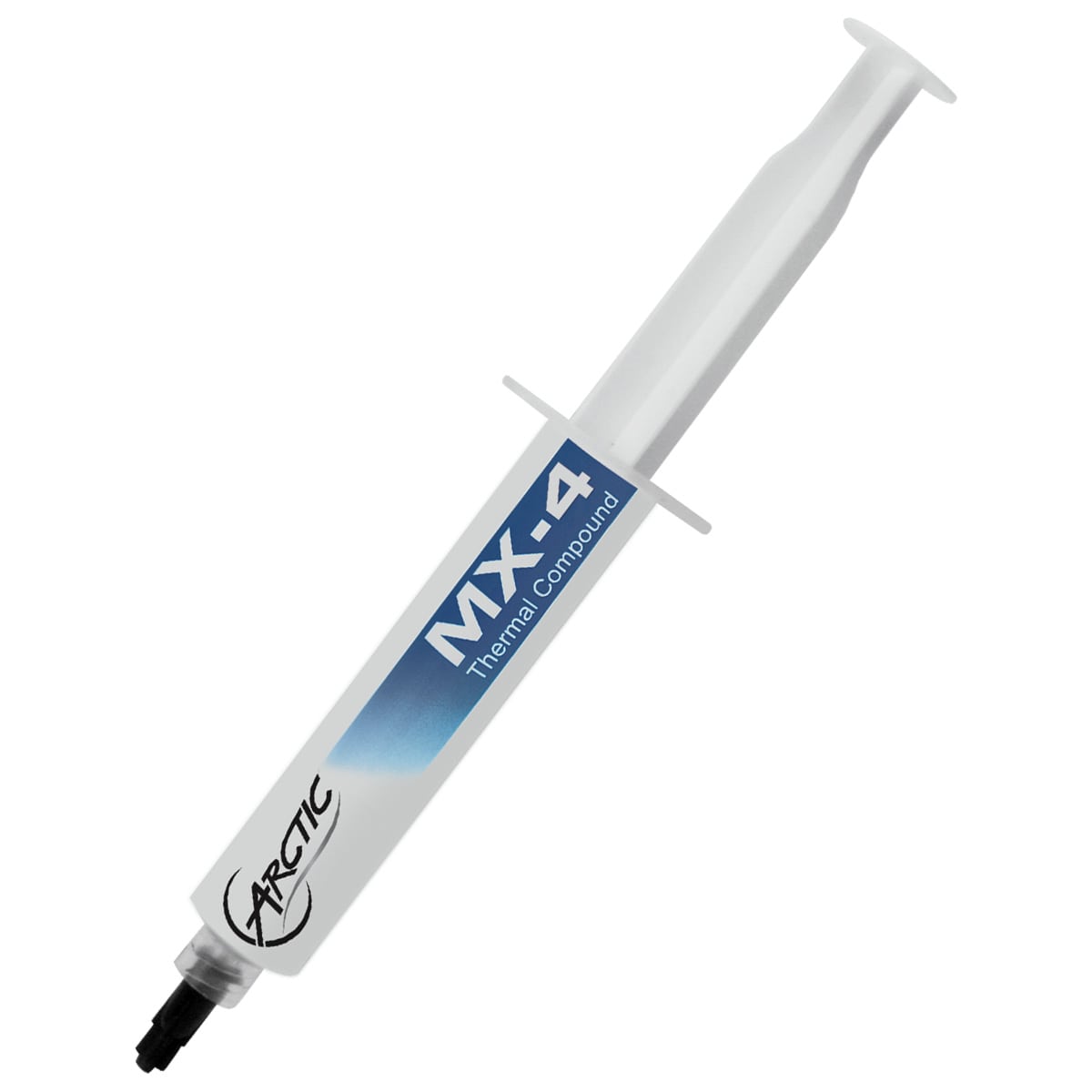
The ARCTIC MX-4 Thermal Compound Paste is a carbon-based paste for thermal interface material and CPU coolers. One thing that makes this paste better than most thermal gels on the market is its carbon microparticles, which have exceptionally high thermal conductivity. Thanks to its composition, the ARCTIC MX-4 Thermal Compound Paste is considered better than liquid metal.
Other than efficient heat dissipation, this thermal paste also guarantees safe application thanks to its metal-free properties. It is also non-electrical conductive, a feature that comes in handy when preventing any instances of electrical shorts. As such, your VGA cards and CPU are adequately protected adding to your computer’s durability.
The ARCTIC MX-4 Thermal Compound Paste is also easy to apply and is recommended for beginners. However, it guarantees stability, allowing you to overclock with ease without damaging or overheating your computer. Lastly, the ARCTIC MX-4 Thermal Compound Paste is highly durable and once applied, it can serve your computer effectively for up to eight years.
Check Price OnlineNoctua NT-H1 Thermal Paste
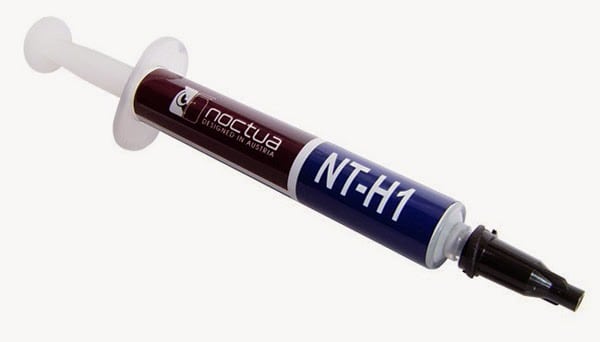
The Noctua NT-H1 Thermal Compound is a thermal interface material capable of adding to your computer’s performance significantly. This thermal paste has a 4.1 ml volume that can serve your needs at least 15 times. Unlike some of the other pastes on the list, it only comes in one color, gray, and a gravity of 2.49 grams per cubic centimeter.
The biggest ingredient in Noctua NT-H1 Thermal Compound is NT-HI; a fused compound with a wide variety of micro-particles. This part helps the Noctua NT-H1 Thermal Compound minimize thermal resistance and add stability to your computer’s performance. Also, it is easy to apply and remove but should not be stored for more than two years when opened.
Two years might be a disadvantage to most people considering some pastes are still usable after more than five years. The Noctua NT-H1 Thermal Compound also has a 3-year peak operating time and works best at temperatures between -50 and 110 degrees Celsius. However, you are recommended to use this product in temperatures ranging from -40 to 90 degrees Celsius.
Coollaboratory Liquid Ultra Thermal Paste Compound Grease for CPU Processor Heatsink
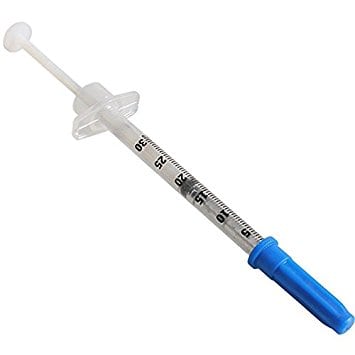
The Coollaboratory Liquid Ultra Thermal Paste is 100% metal and as such can guarantee a significant drop in temperature. This feature guarantees stability for your computer and can pave the way for high-performance tasks such as online gaming or streaming. Most people avoid metal-based thermal pastes partly due to their application.
However, with a commercial brush applying the Coollaboratory Liquid Ultra Thermal Paste is an easy task. However, ensure that the processor and heatsink are thoroughly cleaned before gently applying this paste. Also, ensure that you do not use too much pressure as this cream is pasty and spreads very fast.
It is important to coat your head spreader’s edges to prevent further spread of this paste after reinstalling your computer’s components. A little drop is enough for a standard processor, but commercial machines require slightly more Coollaboratory Liquid Ultra Thermal Paste to function properly.
Cooler Master High-Performance Thermal Paste
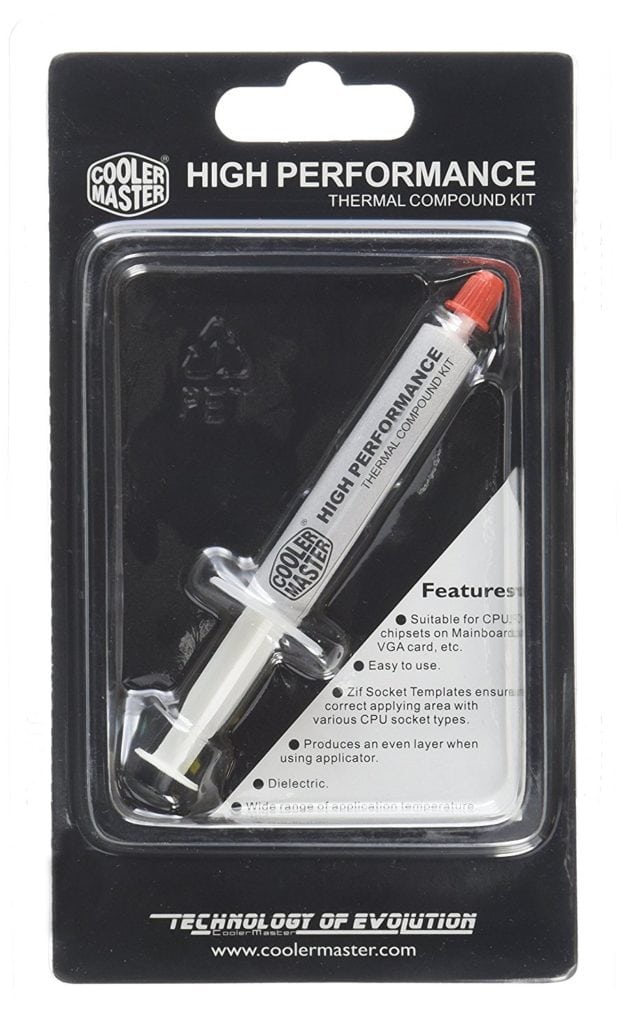
Cooler Master High-Performance Thermal Paste is not only ideal for your CPU and heatsink but also the mainboard and VGA card just to mention a few. Its best feature is Zif Socket Templates, which help guarantee proper application on various CPU socket types. To achieve the perfect spread, you are advised to use an applicator.
While some items on this list such as the ARCTIC MX-4 Thermal Compound Paste do not require special apparatus to apply, the Cooler Master High-Performance Thermal Paste requires these tools seeing it has a higher temperature cover. Its composition entails grease-like silicon compounds filled with heat conductive metal oxides.
As such, you are guaranteed higher and better thermal conductivity, higher temperature stability, and low bleeding whenever you purchase the Cooler Master High-Performance Thermal Paste.
How to remove thermal paste compound
Thermal paste removal is much easier compared to its application. However, it is effective only if all instructions are followed to the letter. The first step is switching off your computer, disconnecting all the cords/removing the battery if it’s a laptop, and pressing down the power button for five seconds to release all residual current.
After these steps, wear protective gear and open up your computer. After removing the heatsink, dust its vents far from the other computer components then scrape off the paste using a spudger. However, do it carefully so as not to damage any nearby parts or dent the heat sink further.
If you are worried that the spudger will do more harm than good to your heatsink, you can use a paper towel or dry cloth to remove the thermal paste. The next step involves removing the remaining thermal gel using q-tips or coffee filters dipped in alcohol. If you don’t have any alcohol, you can use thermal-based cleaners.
The wet ends are the most efficient as they make the adhesive moist and loose while the rubbing effects see to its removal. After doing this with your heatsink, repeat the same process with your processor but replace your metallic spudger with a plastic one. Processors are arguably among the most sensitive parts of a computer, seeing that they are made up of parts that are easily damageable.
As such, you need to be careful when rubbing off the thermal paste. Lastly, rub off any thermal paste lodged in other parts of the computer. As mentioned earlier, this product tends to heat up and spread towards the edges. After months of regular computer use, you can expect some of it in other parts of the PC.
Conclusion
Computers are flooding the market and more often than not, it’s the ones with the most features that are sold out. However, a computer’s lifespan is not guaranteed by its features such as better battery-life but rather how well its cooling system. Using the best thermal tape can add stability and longevity to your computer.



